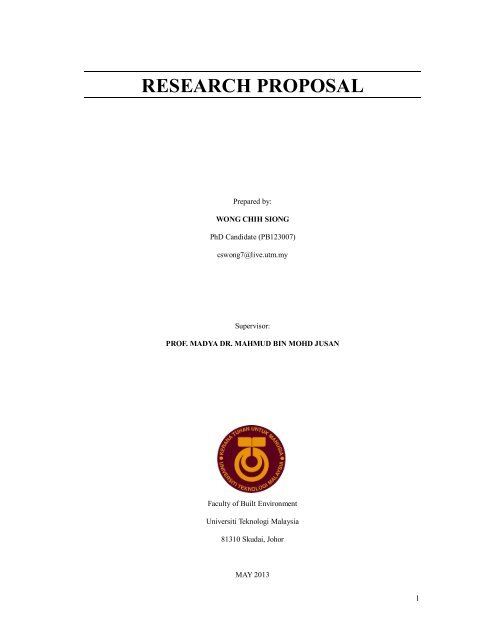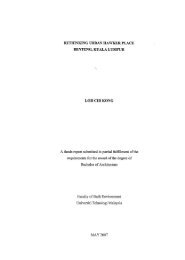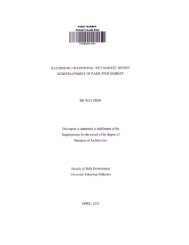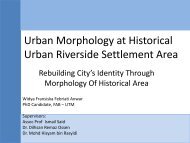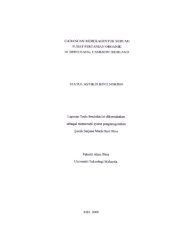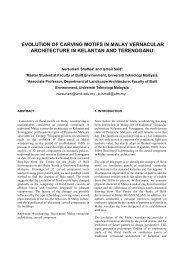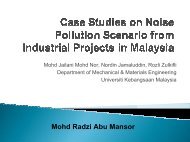RESEARCH PROPOSAL - Faculty of Built Environment - Universiti ...
RESEARCH PROPOSAL - Faculty of Built Environment - Universiti ...
RESEARCH PROPOSAL - Faculty of Built Environment - Universiti ...
Create successful ePaper yourself
Turn your PDF publications into a flip-book with our unique Google optimized e-Paper software.
equirements, such as group and individual work, tutorials, crits, and even relaxation. Oneinteresting finding is different student has different view on spatial characteristics <strong>of</strong> designstudio and place different emphasis on different needs. It prompts an obvious suspicion onwhether a certain environmental characteristics essential for all students. Or perhaps somedesigns are appropriate only for specific student types. This is an area worth to look intoand research further.The learning that occurs within design studio is ideally shaped and supported by its spatialdesign. The design <strong>of</strong> the studio is a key element to successful learning for architecturestudents. But the question arises: What distinguishes a design studio that is successful inattracting and challenging students? So, the problem now is whether designers haveconcrete idea on the design characteristics <strong>of</strong> a supportive design studio. Or they justdesign the studio space based on their intuition or personal preferences. For example,Board <strong>of</strong> Architects Malaysia (LAM) in its clause 4.14 <strong>of</strong> the Policy and Criteria forAccreditation stating that 2.5 sq. m area <strong>of</strong> dedicated work space is required for eachstudent in a studio. Is that the optimal space required by student? Is it sufficient or toomuch? We could justify that figure with empirical research. That is why Rapoport (2005)emphasized on the important <strong>of</strong> knowing and keeping up with the literature. He believedthat design should be the product <strong>of</strong> up-to-date research. However, the design studio isunfortunately being minimally studies in general (Lueth, 2008). As a result, the lack <strong>of</strong>systematic documentation causes potential bottleneck for designers, educators and studentsin better understanding <strong>of</strong> design characteristics <strong>of</strong> studio. It is indeed very difficult t<strong>of</strong>acilitate any positive change in design studio environment without systematicunderstanding <strong>of</strong> interaction process between students and studio environmental setting. Tomake the situation even worst is decisions making power about studio facilities tend to bein the hand <strong>of</strong> few people who are not direct users. Building a supportive design studioshall require direct input from those who actually use the space either the students oreducators. So, the best way to understand the design aspect <strong>of</strong> the studio will be assessingusers about how they perceive and use the environment.8
Osman &Demirkan (2000)Concern: Students’ privacy preference indesign studioFinding: Privacy preference in betweenmale and female shows no difference interm <strong>of</strong> solitude, reserve, anonymity, andisolation. The only different is male tends toenjoy intimacy with friend rather thanfamily whereas female preferred the otherway around.Interior designstudio at BilkentUniversity,Bilkent, Ankara,TurkeyPrivacy dimension:- Personal space- Territoriality- CrowdingHuang (1998)Concern: Open-plan design studioFinding: A conceptual model <strong>of</strong> the physicaland social-psychological environment foropen-plan landscape architecture designstudioDesign studio forLandscapeArchitecture atUniversity <strong>of</strong>Guelph, Guelph,Ontario, CanadaPhysical Factors:- Enclosure- Floor Area- Layout- FurnitureAmbient Factors:- Lighting- Windows- Air Quality- NoisePsychophysicalFactors:- Communication- Personalization- Privacy(Territoriality,Personal Space,Crowding,Occupancy)- Appearance- StatusAbdullah et al.(2011).Concern: Possible design approach inplanning and designing architecturelearning spacesMalaysia- Studio culture- Learning spacesFinding: Architecture learning is notrestricted to design studio as the builtenvironment and the landscape can beregarded as a place where learning occurs.Musa et al.(2012a).Concern: Indoor environmental quality -Lighting performanceFinding: The lighting setting is not withinthe range <strong>of</strong> Malaysian Code <strong>of</strong> Practice onIndoor Air Quality. Students are still willingto use the studio as they perceived it as notabnormal.Year 3architecturedesign studio at<strong>Universiti</strong>KebangsaanMalaysia (UKM),MalaysiaLightingMusa et al.(2012b).Concern: Indoor environmental quality -TemperatureFinding: The temperature setting is notwithin the range <strong>of</strong> MS 1525:2007.However, such condition does not stoppingstudents to work in the studio for longhours.Year 3architecturedesign studio at<strong>Universiti</strong>KebangsaanMalaysia (UKM),MalaysiaTemperature10
Che-Ani et al.(2012)Concern: Indoor <strong>Environment</strong>al Quality(IEQ) <strong>of</strong> architecture design studioFinding: Most <strong>of</strong> the architecture studentagreed that the temperature comfort,humidity, day lighting, glare andbrightness are most important for internalstudio environmentYear 3architecturedesign studio at<strong>Universiti</strong>KebangsaanMalaysia (UKM),Malaysia- Temperature- LightingNasir et al.(2011)Kurt (2009).Duggan (2004)Concern: Identification <strong>of</strong> Indoor<strong>Environment</strong>al Quality (IEQ) Parameter inCreating Conducive Learning <strong>Environment</strong>for Architecture StudioFinding: Indoor <strong>Environment</strong>al Quality(IEQ) Parameter for architecture studioincludes thermal comfort, air quality,disturbances, control, appearance, generalatmosphere and lighting.Concern: Traditional design studio versusconstructivist studioFinding: Characteristics <strong>of</strong> traditional studioenvironments in comparison toconstructivist studio.Concern: The Changing Nature <strong>of</strong> theStudio as an Educational SettingFinding: Challenges faced by the users andproviders <strong>of</strong> studio space in tacklingunacceptably low space utilization- - Thermal comfort- Ventilation- Noise- Suspendedmaterials in the air- The chemicalcontentcomposition- - Traditional studioenvironments- Constructiviststudio- - Studio spaceutilization- Studio CultureLueth (2008).Concern: Student perception <strong>of</strong> learningexperiences in design studiosFinding: The students described theirlearning experiences as inter-relational,perceived the experiences as transitional,and felt that their learning experiences aidedin the production <strong>of</strong> outcomes.Architecturestudents fromfirst- throughfourth-year atIowa StateUniversity, UnitedStates- LearningexperiencesOchsner (2000)Concern: A Psychoanalytic Perspective onInteraction in the Design StudioFinding: The nature <strong>of</strong> the interactionbetween instructors and students in thestudio environment shall be examined underthe psychoanalytic perspective- - Instructors- Students- Studioenvironment11
9. Theoretical FrameworkThis study is based on person-environment relationship in term <strong>of</strong> transactional psychologyapproach. Kopec (2012) defines transactional theory as “a level <strong>of</strong> inquiry thatconcentrates on the patterns <strong>of</strong> relationships and contends that the human-environmentrelationship is mutually supportive”. The idea is that the environment and user isconstantly affecting each other. So, the design setting <strong>of</strong> the Architecture Design Studiomay influences students learning and studying bahaviour. Students behave in certain waysis mainly due to the way they perceive the level <strong>of</strong> affordance in design studio. And theirperception is speculated greatly affected by their unique personality pr<strong>of</strong>ile among them.The theoretical framework is thus being developed to discuss the rationale <strong>of</strong> therelationship in design studio context. So, the variables involved in this study will be:i. Dependent variable: Perception <strong>of</strong> design as satisfying student privacy needsii. Independent variable: Spatial characteristics <strong>of</strong> architecture design studio, studentpersonalityFigure 1: VariablesSpatial Characteristics <strong>of</strong> Design StudioPerception <strong>of</strong> Designas Satisfying Student NeedsStudents’ PersonalityIndependent VariableDependent VariableArchitecture students’ perception <strong>of</strong> studio design is the main interest in this study.It is adependent variable regarding the perceived quality <strong>of</strong> design acting as determinant insatisfying students educational learning and studying needs related to privacy dimension.On the other hand, spatial characteristic <strong>of</strong> design studio and student personality are twoindependent variables that cause the dependent variable, perception <strong>of</strong> studio design to12
change in value. Dependent variable and independent variable can be referred as respondvariable and predictor variable respectively (Zainudin, 2012).Firstly, spatial characteristics <strong>of</strong> design studio as environmental aspect is one <strong>of</strong> theindependent variables could be categorized into technical and functional performancerequirements. This idea is referring to the performance appraisal framework <strong>of</strong>architectural design studio facilities developed by Mohammad A. Hassanain, MohammedAlhaji Mohammed and Murat Cetin (2012). Technical performance requirements areportrayed as the background setting to carry out activities while functional performancerequirement have to do with the facilities that support users’ activities (Preiser et al., 1988).Mainly the technical performance necessities <strong>of</strong> architectural design studio space embracethermal, visual and acoustical comfort, along with fire safety and indoor air quality. Themain functional requirements <strong>of</strong> architectural design studio room comprise layout <strong>of</strong> theworkstation and quality, plus inside finishes, support services and group-gathering space.All these facilities permit students to function pr<strong>of</strong>iciently in carrying out their studioworks.Secondly, the individual difference <strong>of</strong> students is another independent variable that playssignificant role in this study. Person is one <strong>of</strong> the two considerations inperson-environmental relationship. Individual differences, situational factors, socialconditions and cultural factors fall under the human being spectrum in the eclectic modelapplied to learning space by Bell, P. A., Greene, T. C., Fisher, J. D., & Baum, A. (2001).However, the individual difference is the only factor considered in this study due to thecomplexity <strong>of</strong> the research design if involving all other factors. Student personality relatedto individual difference is the main focal point in this study. There is various humanbehaviour, however order in fact exists in such random variation. It is personality, aconsistent behaviour patterns (Myers & McCaulley, 1985; Burger, 2011). Personality canbe explained using six general approaches according to Burger (2011) namely thepsychoanalytic approach, the trait approach, the biological approach, the humanisticapproach, the behavioral/social learning approach, and the cognitive approach. This study13
employs the trait approach that assumes that student’s differences in behaviors arerelatively stable over time and across situations. Under trait approach, student personalitytypes are examined using the influential model <strong>of</strong> Isabel Myers and Katherine Briggs(Myers, 1980; Myers & McCaulley, 1985), Myers-Briggs Type Indicator (MBTI) built onJung’s (1923/1971) theory <strong>of</strong> psychological type. Isabel Myers and Katherine Briggsdescribes individual differences in four dichotomous personality dimensions namelyExtraversion (E) or Introversion (I), Sensing (S) or Intuition (N), Thinking (T) or Feeling(F), Judgment (J) or Perception (P) as shown in Table 2. These various dimension cancombine and produce sixteen different personality types.Table 2: Four Dichotomies <strong>of</strong> Myers-Briggs Type Indicator (MBTI)Where do we get our energy?Extraversion (E)Introversion (I)Prefers to draw energy from the outer worlds <strong>of</strong> Prefers to draw energy from the inner world <strong>of</strong>activity, people and thingsreflections, feelings and ideasHow do we take in information?Sensing (S)Intuition (N)Prefers to focus on information gained from the five Prefers to focus on patterns, connections andsenses and on practical applicationspossible meaningsHow do we make decisions?Thinking (T)Feeling (F)Prefers to base decision on logic and objective Prefers to base decisions on valuing process,analysis <strong>of</strong> cause and effectconsidering what is important to peopleHow do we organize our world?Judgment (J)Perception (P)Like a planned, organized approach to life and Likes a flexible, spontaneous approach and prefersprefers to have things decidedto keep options openHuman are basically visual beings (Gifford & Ng, 1982). However, different people willperceive thing in different way due to their highly subjective nature <strong>of</strong> human characteristic.Their behaviour is depending on the manner they interpret the environment setting. Strange& Banning (2001) stated that, “Whether individuals are attracted to a particularenvironment or satisfied and stable within that environment, is a function <strong>of</strong> how theyperceive, evaluate, and construct the environment. In effect, their perceptions are thereality <strong>of</strong> that environment for them.” Dependent variable, architecture students’ perception14
<strong>of</strong> studio design in this study is based on the James J. Gibson’s ecological approach toenvironmental perception.Gibson’s theory <strong>of</strong> affordance illustrates the ability <strong>of</strong> humanin organizing individual environmental features into identical patterns based on perceivedinformation within an environment (Gibson, 1976, 1979). He believed the arrangement <strong>of</strong>environmental substances provides direct and immediate meaning <strong>of</strong> its functions. Gibsonargued that architects and space users perceive built environment in different manner(Gibson, 1976). Architects trained to see form and shape but space users see affordance <strong>of</strong>the place. In other words, space users perceive what the place able to provide and do forthem. The functional aspect <strong>of</strong> the space matter the most rather than the appearances <strong>of</strong> it.Understanding how students perceive the studio environment is vital to the effective studiodesign. The affordance level provided by studio is analyzed by exploring the manner <strong>of</strong>students perceive, utilize and shape the studio environment. In this study, the impact onprivacy dimensions, that spatial characteristics <strong>of</strong> a design studio has, is carefullyexamined through students’ perception. And it is examined by using Pedersen’s six states<strong>of</strong> privacy. Since the factors <strong>of</strong> personal space, privacy, territoriality and crowding, referredto as environmental psychology mechanisms (Gifford, 1987) result in the preference or nonpreference <strong>of</strong> a studio environment, they should be considered as part <strong>of</strong> this study.15
Figure 2: Theoretical FrameworkIndependent VariableSpatial Characteristics <strong>of</strong> Design StudioTechnical- Visual Comfort- Thermal Comfort- Acoustical Comfort- Fire safetyFunctional- Furniture- Layout- Interior Finishes- Brainstorming space- Support ServicesStudents’ Personality1. Where do we get our energy?2. How do we take in information?3. How do we make decisions?4. How do we organize our world?Dependent VariablePerception <strong>of</strong> Designas Satisfying Student Needs1. Perceiving2. Utilizing3. ShapingExpected OutcomeUsers’ Design Preference(Privacy Dimension)According to Their PersonalityPersonality Pr<strong>of</strong>ile Types:Myers-Briggs Type Indicator1. Extraversion (E) or Introversion (I)2. Sensing (S) or Intuition (N)3. Thinking (T) or Feeling (F)4. Judgment (J) or Perception (P)Privacy Preferences:Pedersen’s Six States <strong>of</strong> Privacy1. Solitude2. Reserve3. Intimacy with family4. Intimacy with friends5. Anonymity6. IsolationDimensions <strong>of</strong><strong>Environment</strong>al Psychology1. Personal Space2. Territories3. Crowding16
10. Scope and Limitation <strong>of</strong> the StudyThis research study like any other studies has its own limitations. As a matter <strong>of</strong> fact, allresearch studies have a finite scope and limitation (Zainudin 2012). The selected unit <strong>of</strong> theanalysis in this study is the private college students pursuing 3-year study in Architecture.The study will be carried out in the School <strong>of</strong> Architecture in east Malaysia. In other words,the population <strong>of</strong> this study is defined as architecture students studying in the privatecollege pursuing Diploma in Architecture in east Malaysia context. So, this study has thefollowing specific scope:i. Students in the private collegeii. School <strong>of</strong> Architecture onlyiii. 3-year Diploma in Architecture programmeiv. East Malaysia contextDue to the limitation <strong>of</strong> scope especially the selected population, the findings <strong>of</strong> this studymight not be generalized to other population. As students from other programme <strong>of</strong> studymight pose different characteristic, the findings might not be that valid. For example, thestudents who major in Interior Design, Landscape Architecture or Urban Planning mightfind the findings do not reflect the real situation in their studio environment.Another limitation is this study only measures the perception <strong>of</strong> the students withoutconsidering the perception from the perspective <strong>of</strong> educators involving in the teachingactivities in design studio. The findings would be more informative as the comparison <strong>of</strong>the two data set groups can be computed. However, the educators’ perception has to beexcluded from this study due to the constraint <strong>of</strong> time limitation.Apart from the limitation mentioned above, this study employs the cross-sectional designthat will only measure students’ perception score once throughout their study. As a result,the findings may not be able to provide the comparison information on the change <strong>of</strong>students’ perception against time. As we all know that architecture education requires longterm commitment from around five to six years. Therefore, the study will be moreinsightful if perception <strong>of</strong> the some respondents is being evaluated at different time interval17
throughout their study. However, longitudinal design will not be employed in this study asit requires a very long duration <strong>of</strong> time.11. Significance <strong>of</strong> StudyThis study is significant in adding a new body <strong>of</strong> knowledge regarding students’perceptions on design for Architecture Design Studio in Malaysia context. Therefore, thefindings would provide a clear sense <strong>of</strong> design direction especially related to privacy,personal space, territories, and crowding issues for Architecture Design Studio in bothpublic and private colleges or universities. Designers will need some guideline to createpositive studio environment if students’ behaviour is greatly affected by the designcondition <strong>of</strong> studio setting.Designers require the knowledge <strong>of</strong> the way students perceive and use the design studiospace as the basis for right decisions throughout the design process. It is important, then,for designers to know, understand and apply the findings in creating valid and responsibledesign studio that able to support the exact functions for architectural studies. If this studyproves that students’ personality have significant effects on their perception on the design<strong>of</strong> Architecture Design Studio, then the understanding <strong>of</strong> this linkage in betweenpersonality and studio design will help designers in making conscious design decisions thatare more meaningful to users. In other words, designers are able to propose a well defineddesign studio for the users as a science based through well researched data and findings.Well designed design-studio will elevate the function <strong>of</strong> its environment in supportingvarious learning and teaching activities within the space for both the students andeducators. This study is therefore play a significant role in contributing design knowledgeand blue print both for improving existing design studio condition as well as for designinga new one.18
12. Research MethodThis study aims to investigate the correlation between architecture student personality andtheir perception toward the physical design <strong>of</strong> studio environment in fulfilling their privacyneed in architectural educational studies. It will explore the impact <strong>of</strong> studio’s spatialcharacteristics onto different students through the lenses <strong>of</strong> student personality pr<strong>of</strong>iletypes. Student bahaviour will be examined under environmental psychology perspectiverelated to the person-environment congruence, privacy, personal space, territories, andcrowding. Student perception <strong>of</strong> studio design is thus revealing those design features thatsatisfy their privacy needs to perform their design works pr<strong>of</strong>iciently.This study will utilize the mixed methods sequential explanatory design for the purpose <strong>of</strong>data collection. The mixed methods sequential explanatory approach mainly consists <strong>of</strong>two particular stages: quantitative followed by the qualitative phase (Tashakkori & Teddlie,1998; Creswell, 2003, 2005).Figure 3: The Mixed-Methods Sequential Explanatory DesignFirst Phase:Quantitative Data1. Surveys (Questionnaires)Second Phase:Qualitative Data1. Focus Group InterviewsResultsConclusion based onmixing both qualitative andquantitative dataThe mixed-methods sequential explanatory design consists <strong>of</strong> two distinct phases:Quantitative followed by qualitative.This design collects and analyzes the quantitative data at the very first stage. Quantitativedata in this stage is collected through questionnaires surveys. Data regarding students’personality pr<strong>of</strong>ile types can be acquired by Myers-Briggs Type Indicator (MBTI).Students’ privacy preference will employ Pedersen’s Six States <strong>of</strong> Privacy questionnaires.Both questionnaires will be analyzed using SPSS s<strong>of</strong>tware for inferential statistic analysis.19
The qualitative or text data will then be collected and analyzed during the second phase <strong>of</strong>the process. The proposed data collection technique for the qualitative phase issemi-structured focus group interviews. This interview aims to find out students perceptiontowards spatial characteristics <strong>of</strong> architecture design studio. It will be analyzed usingNVivo for content analysis. The second phase is built on the first phase and is connectedduring the intermediate level <strong>of</strong> the study (Creswell & Plano Clark, 2007). It will help toelaborate and explain the results that are obtained during the initial phase <strong>of</strong> the design.The reason for this type <strong>of</strong> approach is that the quantitative data and the subsequentanalysis will provide an overall understanding <strong>of</strong> the problem <strong>of</strong> the study. Both thequalitative data and the analysis <strong>of</strong> the researcher will refine the statistical results throughthe exploration <strong>of</strong> the views <strong>of</strong> the participants with depth (Rossman & Wilson, 1985;Creswell, 2003).20
Figure 4: Flowchart <strong>of</strong> Research DesignLiterature ReviewArchitecture Design Studio– Spatial Characteristics<strong>Environment</strong>al Psychology –Person-<strong>Environment</strong> Congruence,Privacy, Personal Space,Territories, CrowdingIndividual Differences– Personality TypesPerception <strong>of</strong> Designas SatisfyingUser’s Privacy NeedsData CollectionQuantitative Followed by QualitativeQuantitative: Questionnaires SurveyQualitative: Focus Group InterviewStudents’ Personality Type– Myers-Briggs Type Indicator(MBTI)Students’ Privacy Preference– Pedersen’s Six States <strong>of</strong> PrivacyPreferences and Perceptiontowards Spatial Characteristics <strong>of</strong>Architecture Design StudioData AnalysisData AnalysisInferential Statistical Analysis (SPSS)Content analysis (NVivo)Finding and DiscussionCorrelation between Students’ Personality and Their Perception on Spatial Characteristics <strong>of</strong> DesignStudio as Satisfying Their Privacy Needs in Learning and StudyingDesign Attributes Typology (Privacy Dimension) <strong>of</strong> Architecture Design Studio21
13. Anticipated FindingsThis study will reveal the following findings:i. The physical environmental factors <strong>of</strong> architecture design studio that play a significantrole in influencing architecture students’ study and learning activities.ii. The dominant characteristics <strong>of</strong> architecture students based on Myers-Briggspersonality types.iii. Architecture students’ perception on the design affordance <strong>of</strong> Architecture DesignStudio in supporting their learning and study activities. Such perception shall disclosedesign preferences related to Pedersen’s six states <strong>of</strong> privacy as well other issues likepersonal space, territories, and crowding.From the above mentioned findings, the relationship between students’ personality andtheir perception <strong>of</strong> the design <strong>of</strong> architecture design studio will be established. Students’perception will provide a clear picture about the design attributes preference based on theirdifferent category <strong>of</strong> personality. Design attributes in this case are mainly related to fourmain areas <strong>of</strong> concern namely privacy, personal space, territories, and crowding.Subsequently, the typology <strong>of</strong> design attributes could be formulated as accordance to fourdichotomous <strong>of</strong> Myers-Briggs Type Indicator (MBTI). This typology will be a usefuldesign model for designer in making critical design decision for architecture design. On theother hand, such typology could be used by researcher for reference and further studies.This study seeks to provide necessary information to understand the architecture designstudio from a more holistic perspective. The understanding on the interaction betweendesign studio environment and students through the lenses <strong>of</strong> different personality pr<strong>of</strong>ilewill be a stepping stone in shaping studio environment that is congruent with intendedbehaviour. That is the ideal design studio setting or known as homeostasis in the domain <strong>of</strong>environmental psychology.22
14. Research ScheduleTable 3: Research ScheduleNo.Stages <strong>of</strong> StudyYear 1 Year 2 Year 3 Year 4Sem 1 Sem 2 Sem 1 Sem 2 Sem 1 Sem 2 Sem 1 Sem 21 Proposal2 Literature review3Problem statement, Aim,Objective formulation4 Methodology5 Pilot study6 Data collection7 Data input and analysis8 Findings9 Writing10 Submission and Viva11 Publication * ** ** **** Journal Paper (Scopus)** Conference Paper*** ISI Paper23
15. ReferencesAbdullah, N. A. G., Beh, S. C., Tahir, M. M., Ani, A. I. Che, & Tawil, N. M. (2011). Architecture designstudio culture and learning spaces: a holistic approach to the design and planning <strong>of</strong> learningfacilities. Procedia - Social and Behavioral Sciences, 15, 27-32.Adler, R., & Towne, N. (1987). Looking out-looking in. Austin, TX:Holt, Rinehart and Winston.Altman, I. (1970). Territorial behavior in humans: An analysis <strong>of</strong> the concept. In L. Pastalan & D. Carson(Eds.), Spatial behavior <strong>of</strong> older people (pp. 1-24). Michigan: The University <strong>of</strong> Michigan-WayneState University.Astin, A. W. (1968). The college environment. Washington, DC: American Council on Education.Astin, A. W. (1993). An empirical typology <strong>of</strong> college students. Journal <strong>of</strong> College Student Development, 34,36-46.Barker, R. G. (1968). Ecological psychology: Concepts and methods for studying the environment <strong>of</strong> humanbehavior. Stanford, CA: Standford University Press.Bell, P. A., Greene, T. C., Fisher, J. D., & Baum, A. (2001). <strong>Environment</strong>al psychology: Lawrence ErlbaumAssociates, Incorporated.Burger, Jerry M. (2011). Personality. Australia; Belmont, Calif.: Wadsworth Cengage Learning.Che-Ani, A. I., Tawil, N. M., Musa, A. R., Yahaya, H., & Tahir, M. M. (2012). The architecture studio <strong>of</strong><strong>Universiti</strong> Kebangsaan Malaysia (UKM): Has the indoor environmental quality standard beenachieved? Asian Social Science, 8(16), 174-183.Chism, N. (2006). Challenging Traditional Assumptions and Rethinking Learning Spaces. In D. Oblinger(ed.), Learning spaces, Washington D.C.: EDUCAUSE.Clark, B., & Trow, M. (1966). The organizational context. In T. Newcomb & E. Wilson (Eds.), College peergroups: Problems and prospects for research (pp. 17-70). Chicago: Aldine.Creswell, J. W. (2003). Research Design: Qualitative, Quantitative, And Mixed Methods Approaches. 2nd ed.Thousand Oaks, CA: Sage.Creswell, J. W. (2005). Educational Research: Planning, Conducting, And Evaluating Quantitative AndQualitative Approaches To Research. 2nd ed. Upper Saddle River, NJ:Merrill/Pearson Education.Creswell, J. W., & Plano Clark, V. L. (2007). Designing And Conducting Mixed Methods Research.Thousand Oaks, CA: Sage.Deasy, C. M. & Lasswell, T. E. (1985). Designing Places for People: A Handbook on Human Behaviour for24
Architects, Designers and Facility Managers. New York: Broadway.Dewey, J. (1993). How we think: A restatement <strong>of</strong> the relation <strong>of</strong> reflective thinking to the educative process.New York: D. C. Heath.Demirbas, O. O. (1997). Design studio as a life space in architectural education: Privacy requirements.Master Thesis. Ankara: Bilkent.Duggan, Fiona. (2004). The changing nature <strong>of</strong> the studio as an educational setting: CEBE.Evans, G. W., & McCoy, J. M. (1998). When building don’t work: the role <strong>of</strong> architecture in human health.Journal <strong>of</strong> <strong>Environment</strong>al Psychology, 18, 85-94.Gibson, J. J. (1976). The theory <strong>of</strong> affordances and the design <strong>of</strong> the environment. Paper presented at theannual meetings <strong>of</strong> the American Society for Aesthetics, Toronto.Gibson, J. J. (1979). The ecological approach to visual perception. Boston: Houghton Mifflin.Gifford, R., & Ng, C. F. (1982). The relative contribution <strong>of</strong> visual and auditory cues to environmentalperception. Journal <strong>of</strong> <strong>Environment</strong>al Psychology, 2, 275-284.Gifford, R. (1987). <strong>Environment</strong>al Psychology: Principles and Practice. Allyn and Dacon: Massachusetts.Gifford, R. (2002). Enviromental psychology: Practice and principles (3 rd ed.). Colville, WA: Optimal Books.Hall, E. T. (1969). The hidden dimension. Garden City, NY Anchor Books.Hassanain, Mohammad A., Mohammed, Mohammed Alhaji, & Cetin, Murat. (2012). A multi-phasesystematic framework for performance appraisal <strong>of</strong> architectural design studio facilities. Facilities,30(7/8), 324-342.Holland, J. L. (1966). The psychology <strong>of</strong> vocational choice: A theory <strong>of</strong> personality types and modelenvironments. Waltham, MA:Blaisdell.Holland, J. L. (1973). Making vocational choices: A theory <strong>of</strong> careers. Englewood Cliffs, NJ: Prentice Hall.Huang, Robin Chi-Feng. (1998). An exploration <strong>of</strong> an open-plan design studio: A conceptual model <strong>of</strong> thephysical and social-psychological environment. Master Thesis. University <strong>of</strong> Guelph (Canada),Canada.John, O.vP., & Srivastava, S. (1999). The Big Five trait taxonomy: History, measurement, and theoreticalperspectives. In L. A. Pervin & O. P. John (Eds.), Handbook <strong>of</strong> personality: theory and research (2 nded., pp.1002-138). New York: Guilford.Kolb, D. (1983). Experiential learning: Experience as the source <strong>of</strong> learning and development. Englewood25
Cliffs, NJ: Prentice Hall.Kopec, D. A. K. (2012). <strong>Environment</strong>al psychology for design (2 nd ed.). Fairchild Books.Kuh, G., Kinzie, J., Schuh, J. & Whitt, E. (2005). Student Success in College: Creating Conditions thatMatter. San Francisco, CA: Jossey-Bass.Kurt, Sevinç. (2009). An analytic study on the traditional studio environments and the use <strong>of</strong> theconstructivist studio in the architectural design education. Procedia - Social and BehavioralSciences, 1(1), 401-408.Lewin, K. (1936). Principles <strong>of</strong> topological psychology. New York: McGraw-HillLueth, Patience Lamunu Opiyo. (2008). The architectural design studio as a learning environment: Aqualitative exploration <strong>of</strong> architecture design student learning experiences in design studios fromfirst- through fourth-year. (Ph.D. Thesis), Iowa State University, United States .Maslow, A. H., & Minz, N. (1956). Effects <strong>of</strong> those aesthetic surroundings: Initial effects <strong>of</strong> those aestheticsurroundings upon perceiving “energy” and “well-being” in faces. Journal <strong>of</strong> Psychology, 41,247-254.Mehrabian, A. (1981). Silent messages (2 nd ed.). Belmont, CA: Wadsworth.Moos, R. H. (1986). The human context: <strong>Environment</strong>al determinants <strong>of</strong> behavior. Malabar, FL:Krieger.Musa, A. R., Abdullah, N. A. G., Che-Ani, A. I., Tawil, N. M., & Tahir, M. M. (2012a). Indoor<strong>Environment</strong>al Quality for UKM Architecture Studio: An Analysis on Lighting Performance.Procedia - Social and Behavioral Sciences, 60, 318-324.Musa, A. R., Abdullah, N. A. G., Che-Ani, A. I., Tawil, N. M., & Tahir, M. M. (2012b). TemperatureAnalysis for Indoor <strong>Environment</strong>al Quality (IEQ) <strong>of</strong> UKM Architecture Studio. Procedia - Socialand Behavioral Sciences, 60, 575-581.Myers, I. B. (1980). Gifts differing. Palo Alto, CA:Consulting Psychologist Press.Myers, I. B., & McCaulley, M. H. (1985). Manual: A guide to the development and use <strong>of</strong> the Myers-BriggsType Indicator. Palo Alto, CA: Consulting Psychologist Press.Nasir, A. R. M., Musa, A. R., Che-Ani, A. I., Utaberta, N., Abdullah, N. A. G., & Tawil, N. M. (2011).Identification <strong>of</strong> Indoor <strong>Environment</strong>al Quality (IEQ) Parameter in Creating Conducive Learning<strong>Environment</strong> for Architecture Studio. Procedia Engineering, 20, 354-362.Obeidat, Asem, & Al-Share, Raed. (2012). Quality Learning <strong>Environment</strong>s: Design-Studio Classroom. AsianCulture and History, 4(2), 165-174.26
Ochsner, Jeffrey Karl. (2000). Behind the Mask: A Psychoanalytic Perspective on Interaction in the DesignStudio. Journal <strong>of</strong> Architectural Education (1984-), 53(4), 194-206.Osman Demirbas, O., & Demirkan, Halime. (2000). Privacy Dimensions: A Case Study In The InteriorArchitecture Design Studio. Journal <strong>of</strong> <strong>Environment</strong>al Psychology, 20(1), 53-64.Port, J. (2003) Physical Infrastructure for Teaching and Learning. Presentation given at ICT PhysicalLearning Spaces workshop, March 2003Preiser, W.F.E., Rabinowitz, H.Z. and White, E.T. (1988), Post-occupancy Evaluation, Van NostrandReinhold, New York, NY.Rapoport, A. (1982). The Meaning <strong>of</strong> the <strong>Built</strong> <strong>Environment</strong>: A Nonverbal Communication Approach:University <strong>of</strong> ARIZONA Press.Rapoport, A. (1994). On 'The Invisible in Architecture'. In Bouman, O., & Van Toorn, R. (Eds.), The Invisiblein Architecture: Academy Editions, Limited.Rapoport, A. (2005). Culture, Architecture, and Design: Locke Science Publishing Company.Rossman, G. B., and B. L. Wilson. (1985). Number And Words: Combining Quantitative And QualitativeMethods In A Single Large-Scale Evaluation Study. Evaluation Review 9 (5): 627-43.San<strong>of</strong>f, H. (1993). Designing a responsive school environment. Children's <strong>Environment</strong>, 10, 140-153.Schön, D. A. (1984). The architectural studio as an exemplar <strong>of</strong> education for reflection-in-action. Journal <strong>of</strong>Architectural Education, 38, 2-9.Schön, D. A. (1987). Educating the Reflective Practitioner. San Fransisco: Jossey-Bass Publishers.Sommer, R. (1969). Personal space. New Jersey: Prentice-Hall.Sommer, R. (1978). Personal Space: The Behavioral basis <strong>of</strong> design. Englewood Cliffs: NJ: Prentice Hall.Stamps, A. E. (1994). Jungian epistemological balance: A framework for conceptualizing architecturaleducation. Journal <strong>of</strong> Architectural Education, 48, 105-112.Strange, C. C. and J. H. Banning (2001). Educating by design: Creating campus learning environments thatwork, Jossey-Bass.Tashakkori, A., and C. Teddlie. (1998). Mixed Methodology: Combining Qualitative And QuantitativeApproaches. Applied Social Research Methods Series, vol. 46. Thousand Oaks, CA: Sage.Temple, P. (2007). Learning Spaces for the 21st century: A Review <strong>of</strong> Literature. Centre for Higher EducationStudies. London: University <strong>of</strong> London.27
Walsh, Bruce W., & Holland, John L. (1992). A theory <strong>of</strong> personality types and work environments. In W. B.Walsh, K. H. Craik & R. H. Price (Eds.), Person–environment psychology: Models and perspectives(pp. 35-69). Hillsdale, NJ, England: Lawrence Erlbaum Associates, Inc.Wicker, A. W. (1984). An introduction to ecological psychology. Cambridge: Cambridge University Press.Zainudin Awang (2012). Research methodology and data analysis (2 nd ed.) Malaysia: UiTM Press.28


